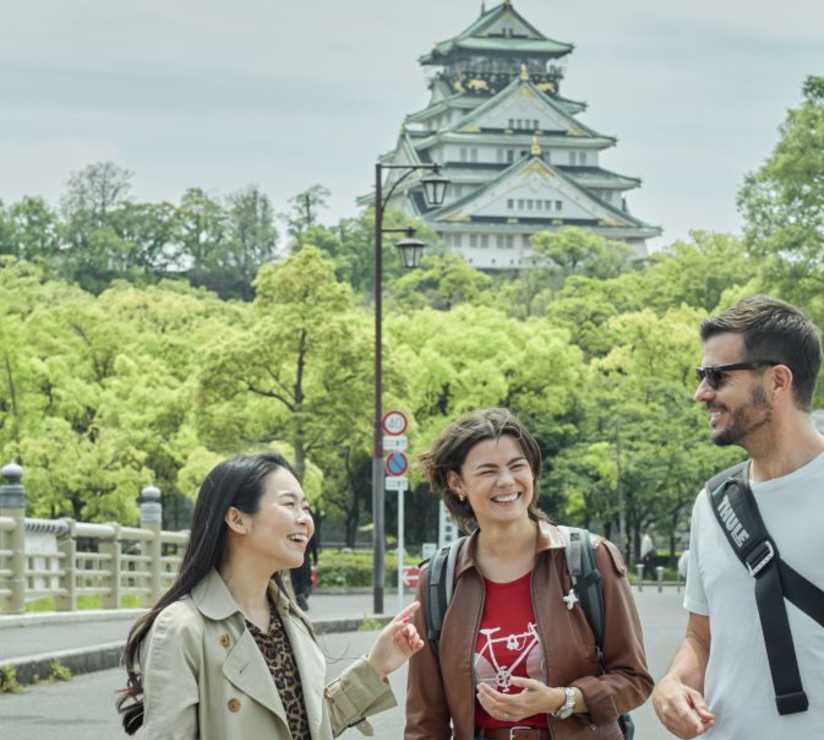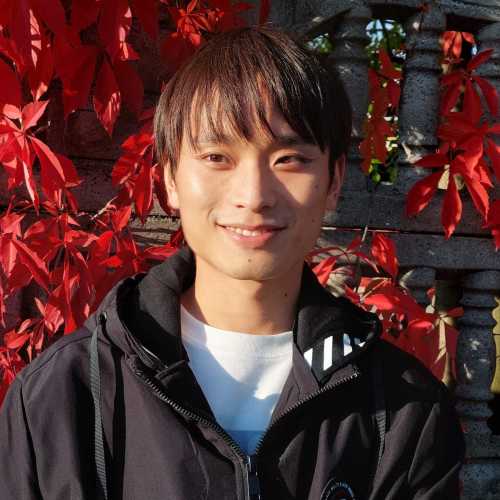Table Of Contents
- Introduction to Osaka: The City of Contrasts and Charms
- One Day in Osaka? Here's How I Actually Do It
- Starting Smart: Arriving at Shin-Osaka Station
- Morning in Osaka Castle Park
- Street Food Stop: Kuromon Market
- Midday Pause: Umeda Sky Building & Floating Garden
- Shopping in Osaka: From Trendy Boutiques to Quirky Finds
- Afternoon Wander: Namba, Hozenji Temple & Covered Arcades
- Evening Vibe: Tsutenkaku, Spa World & Retro Flavor
- Final Bite: Dinner Near Tennoji or Shin-Osaka
- Transportation Logic for One Day Success
- Weather and Seasonal Considerations
- Budget Breakdown and Money Matters
- Is Osaka Worth Visiting in One Day?
- Final Thoughts on Sustainable City Exploration
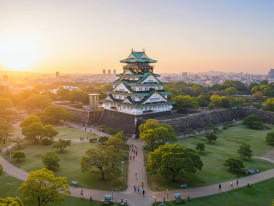
Panoramic morning view of Osaka Castle from park with early joggers
Introduction to Osaka: The City of Contrasts and Charms
Osaka isn’t just another stop on your Japan trip; it’s the city that refuses to fit into a single box. Here in the heart of the Kansai region, you’ll find centuries-old shrines tucked between neon-lit skyscrapers, and the echoes of samurai history mingling with the buzz of late-night ramen joints. Osaka Castle stands as a proud reminder of the city’s resilience, its white walls and sweeping moats a testament of Japanese history. But step outside the castle grounds, and you’re just as likely to stumble into a pop-up art show, a street performer juggling in a covered shopping arcade, or a tech store selling gadgets you didn’t know existed.
What makes Osaka so compelling is this constant dance between tradition and innovation. The city’s energy is infectious. Louder, friendlier, and more unfiltered than you’ll find elsewhere in Japan. Whether you’re drawn by the promise of world-class street food, the pull of Japanese culture, or the thrill of exploring a city that never seems to slow down, Osaka delivers. It’s a place where every corner offers a new surprise.
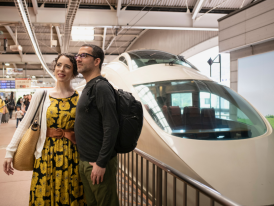
Shinkansen arriving at Shin-Osaka Station
One Day in Osaka? Here's How I Actually Do It
I get it. The idea of cramming Osaka into a single day sounds like tourist madness, the kind of breathless checklist sprinting that leaves you exhausted and slightly confused about what you actually saw. I’ve lived here my entire life, watching friends and family attempt exactly this feat, usually with mixed results.
But here’s what I’ve learned: 1 day in Osaka can work if you’re smart about it. A well-planned 1 day Osaka itinerary, can help you maximize your one day Osaka experience. Not because you’ll see everything (you won’t), but because this city has a particular rhythm that rewards focused attention over frantic coverage.
Most people attempting a day in Osaka are either bullet train day-trippers from Tokyo or Kyoto, or travelers with layovers at Kansai International Airport. Both scenarios create natural time constraints, but they also create focus. When you can’t see everything, you’re forced to see things properly.
My approach isn’t about hitting every famous spot. It’s about understanding Osaka’s particular flavor. The way morning energy builds differently here, how the afternoon light hits the city’s angles, and why evening feels like the city’s real personality finally showing up.
Looking for a private city experience in Osaka?
Explore the city with a local who plans a private day just for you; no groups, no scripts.

Travelers with light luggage walking past map at Shin-Osaka Photo by Arthur Tseng on Unsplash
Starting Smart: Arriving at Shin-Osaka Station
If you’re coming by bullet train, Shin-Osaka Station becomes your natural starting point. The shinkansen bullet train is the most efficient and popular way to travel from Tokyo Station to Osaka, with frequent departures and a travel time of around 2.5 to 3 hours. The JR Pass covers this route on the Hikari and Kodama shinkansen, but not the faster Nozomi trains, making it a convenient and cost-effective option for travelers visiting multiple cities. It’s not the most romantic entry to the city; it’s efficient, functional, built for movement rather than lingering. But that efficiency works in your favor when you’re working with limited time.
The Japan Rail Pass makes this whole exercise more economical, especially if you’re combining Osaka with other cities. From Shin-Osaka, the subway connections are straightforward, the Midosuji Line runs directly through the city’s spine, connecting you to every major district you’ll want to see.
I always tell visitors to leave their larger luggage in the station lockers here. You’ll move faster, feel less conspicuous, and avoid that particular tourist struggle of navigating crowded spaces with unwieldy bags. The lockers cost a few hundred yen for the day, worth every coin for the freedom it buys you.
The morning energy at Shin-Osaka tells you something about Osaka’s character. It’s purposeful without being frantic, efficient without being cold. People move with intention but still make eye contact, still nod acknowledgment to strangers.
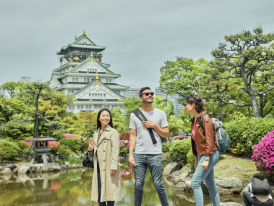
Osaka Castle reflecting in moat
Morning in Osaka Castle Park
From Shin-Osaka, the Midosuji Line takes you directly to Osaka Castle, the city's most famous attraction, in about fifteen minutes. I recommend arriving by 9 AM, when the castle grounds still hold that particular morning quiet before the tour groups arrive.
Osaka Castle itself is a reconstruction - the original was destroyed in World War II - but the castle grounds tell a deeper story about Japanese history and this city’s resilience. The park around this famous attraction fills with locals doing morning exercises, elderly couples taking slow walks, students sitting on benches with textbooks. During cherry blossom season, the entire area comes alive as crowds gather to enjoy the blossoms, making it one of the top spots in the entire city.
I skip the treasure hall inside the castle unless the weather is terrible. The real treasure is the park itself, the way it creates breathing space in an otherwise dense city. Walk the outer moat, notice how the stone foundations were built to last centuries, observe how the morning light changes the castle’s color from gray to gold.
The view from the castle grounds gives you geographic orientation for the rest of your day; from this vantage point, you can see the entire city. You can see toward Umeda in the north, toward Namba in the south. The city spreads in all directions, but from here, it feels manageable, comprehensible.
Morning in the castle park moves at a different pace than the rest of Osaka. People have time here. Conversations happen more slowly. The city’s famous intensity hasn’t fully kicked in yet.
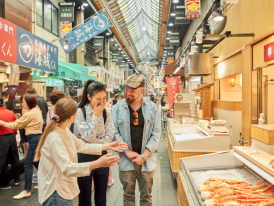
Vendor at Kuromon Market smiling behind counter
Street Food Stop: Kuromon Market
By 10:30, you’re ready for Kuromon Market. The subway takes you directly there — Nippombashi Station puts you right at the market’s edge. This timing is deliberate. Too early, and many stalls haven’t opened. Too late, and you’re fighting crowds for everything.
Kuromon is known as “Osaka’s Kitchen,” and the city is often called Japan's kitchen for its vibrant and diverse food scene. This is where restaurants source ingredients, where locals shop for dinner, where the city’s food culture reveals itself in the most direct way possible.
The Takoyaki here isn’t the best in the city (that honor belongs to smaller neighborhood places) but it’s reliable, hot, and gives you that essential Osaka experience of eating something while standing in a narrow aisle with sauce dripping down your fingers.
I recommend three specific stops: the wagyu beef skewer stall near the main entrance (expensive but worth it, though be aware of the extra cost for premium items), the tamago sandwich vendor (weird but addictive), and any of the fruit stands selling perfectly ripe melon by the slice.
You’ll find a wide range of Japanese food specialties here, from kushikatsu and okonomiyaki to fresh sushi and grilled seafood, making it a must-visit for food lovers.
Street food in Kuromon follows unspoken rules. You eat standing near where you bought it. You don’t walk around with food unless you’re moving between stalls. You make appreciative noises, it’s expected, not performative.
The market energy builds throughout the morning. Vendors call out specials, regulars exchange gossip, tourists ask questions in broken Japanese while locals respond in broken English. Everyone’s figuring it out together.
What if your day in Osaka was planned by someone who knows it — and you?
City Unscripted matches you with a local host who creates a private experience based on your interests, not a set route.

Observation deck view across Osaka Image by Dong Chan KIM from Pixabay
Midday Pause: Umeda Sky Building & Floating Garden
After the market’s intensity, you need altitude and perspective. The Umeda Sky Building, a famous landmark in Osaka, provides both, plus air conditioning and actual seats — luxuries when you’re covering ground on foot.
From Kuromon, take the subway to Umeda Station, one of Japan’s most confusing station complexes, but you only need to find the signs pointing to the Sky Building. It’s a ten-minute walk through underground passages that keep you cool and dry, passing by huge shopping malls in the Umeda district that offer plenty of shopping and entertainment options.
The Floating Garden Observatory sits on the building’s top floors, connected by outdoor escalators that feel mildly terrifying and completely exhilarating. Note that there is an entrance fee required to access the observation deck, which gives you 360-degree views of central Osaka, but more importantly, it gives you processing time.
From this height, the city’s logic becomes clearer. You can see the castle where you started, the market district where you just ate, the Namba area where you’re heading next. The density makes sense from up here, everything is closer than it seems from street level.
The Sky Building also houses restaurants and cafes if you need more substantial food than market snacks. The basement food court offers reliable Japanese fast food (ramen, curry, bento boxes) at reasonable prices.
Midday in Osaka hits differently than morning or evening. The pace accelerates, the heat builds, the energy becomes more focused and intense. Taking this pause allows you to reset before diving into the afternoon’s exploration.
Shopping in Osaka: From Trendy Boutiques to Quirky Finds
If retail therapy is your idea of a good time, Osaka will spoil you for choice. The city’s shopping scene is as diverse as its neighborhoods, think luxury department stores rubbing shoulders with indie boutiques, and bustling markets just a short hop from futuristic malls. Shinsaibashi’s covered arcade is a labyrinth of fashion, cosmetics, and souvenirs, while Namba’s department stores offer everything from high-end brands to the latest Japanese gadgets. For those who crave something offbeat, Amerikamura (Amemura) is Osaka’s answer to Harajuku: a playground of vintage shops, streetwear, and the kind of quirky finds you’ll want to brag about back home.
But shopping in Osaka isn’t just about what you buy, it’s about the experience. Kuromon Market, already famous for its fresh street food, is also a treasure trove of local specialties and edible souvenirs. And if you’re planning to hit multiple shopping districts in a day, the Osaka Amazing Pass is your secret weapon. It gives you unlimited rides on the Osaka Loop Line and other public transport, plus discounts at top attractions like the Umeda Sky Building and Osaka Aquarium. The Sky Building itself is worth a visit for its unique architecture and basement retro food street, while the aquarium’s gift shop is a favorite for quirky marine-themed gifts.
Whether you’re hunting for the latest trends or just want to soak up the city’s vibrant retail culture, Osaka makes it easy to shop, explore, and discover something new at every turn. Just remember: in this city, the best finds are often the ones you weren’t looking for.
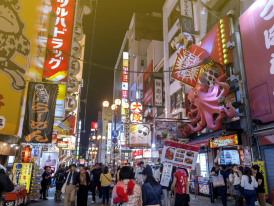
Shoppers walking through Namba covered arcade
Afternoon Wander: Namba, Hozenji Temple & Covered Arcades
The afternoon belongs to Namba, Osaka’s commercial heart and the centerpiece of the Minami district, known for its vibrant atmosphere. From Umeda, the Midosuji Subway Line takes you directly to Namba Station in fifteen minutes.
But before diving into Namba’s chaos, find Hozenji Temple, a tiny shrine tucked behind the main shopping district, marked by a moss-covered statue that locals splash with water for good luck. It’s the kind of discovery that makes you feel like you’re seeing the real city, not just its tourist presentation.
The covered shopping arcades around Namba represent a particular aspect of Japanese culture, the way public and private space blend, how commerce and community intersect. These aren’t American-style malls but something more organic, more integrated into daily life. Shinsaibashi Station serves as a key access point to this bustling shopping area, making it easy for visitors to explore.
Dotonbori runs parallel to these covered areas, and while it’s become tourist central, the afternoon light on the canal creates photo opportunities that even jaded locals appreciate. The giant mechanical signs - the running man, the moving crab; looks slightly ridiculous in daylight but somehow perfect in context.
Namba and its surroundings are home to some of Osaka's top tourist attractions and tourist sites, drawing visitors from around the world to experience the city's unique culture and energy.
The afternoon crowd in Namba moves differently than morning castle-goers or evening partiers. These are people running errands, meeting friends, conducting the business of daily life. You’re witnessing the city’s working rhythm, not its performance mode.
Shopping here ranges from high-end department stores to tiny specialty shops selling things you didn’t know existed. Even if you’re not buying, the browsing provides cultural immersion and people-watching opportunities.
Tip
We match you with the right host, not just any guide.Want to experience the real Osaka with someone who lives there?
A fully private experience, planned and led by a local host who tailors the day to you
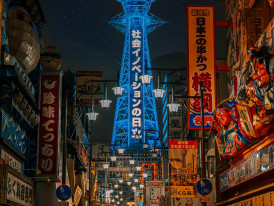
Tsutenkaku Tower lit up at dusk
Evening Vibe: Tsutenkaku, Spa World & Retro Flavor
As afternoon fades to evening, Osaka’s personality shifts into its most characteristic mode. The city that works hard during the day transforms into the city that plays harder after dark. For this transition, head to Tsutenkaku Tower and the surrounding Shinsekai district.
Tsutenkaku represents Osaka’s version of retro charm, not polished vintage but lived-in, slightly worn, completely authentic. Its design was inspired by the Eiffel Tower, earning it the nickname "Eiffel Tower of Osaka" for its iconic shape and cultural significance. The tower itself is worth visiting for the views, but the surrounding streets tell the better story.
Spa World near Tsutenkaku offers something uniquely Japanese, a massive public bath complex with themed floors representing different countries. It sounds gimmicky but provides genuine relaxation after a day of walking. The entry fee includes access to saunas, hot springs, and rest areas where you can actually nap.
If you’re exploring nearby, consider a visit to the Gokuraku-jodo Garden near Shitennō-ji. This tranquil, Buddhist-themed garden is known for its traditional design and peaceful atmosphere, offering a spiritual retreat in the heart of the city.
The neon lights that define evening Osaka begin flickering on around this time. The city doesn’t gradually transition from day to night; it switches modes, like someone turning up the volume and adjusting the lighting for the evening show.
Street energy changes too. Conversations get louder, laughter more frequent. Salarymen begin appearing in groups, heading for after-work drinks. The city’s famous food culture kicks into high gear as restaurants fill with the dinner crowd.
This is when Osaka reveals why locals love it so much. The work-hard, play-hard mentality isn’t just cultural stereotype; it’s observable reality that shapes the city’s evening rhythm.
For more insights into how the city transforms after dark, explore Osaka at night for specific recommendations and hidden gems.

Grilled skewers at small izakaya
Final Bite: Dinner Near Tennoji or Shin-Osaka
As your day winds down, practical considerations reassert themselves. If you’re catching a late bullet train, positioning yourself near Shin-Osaka Station makes sense. If you have more time, Tennoji Station offers excellent dining options without the tourist markup of more central areas. For those seeking a luxury hotel experience, some of the best luxury hotel options in Osaka are conveniently located near Shin-Osaka or Tennoji, offering upscale amenities and prime locations.
Japanese restaurants near both stations cater to locals rather than tourists, which means better prices and more authentic experiences. Look for places with limited English menus and customers in business suits, reliable indicators of quality and value.
The Izakaya culture becomes apparent in the evening. These aren’t just bars but community spaces where neighbors gather, colleagues decompress, and strangers sometimes end up sharing tables and conversation.
If you’re heading back to Shin-Osaka, factor in extra time for potential crowds. Evening rush hour in Osaka is intense but brief; trains run frequently enough that delays rarely last long. Traveling or having dinner between Shin-Osaka and Tennoji typically takes about half an hour.
Extra costs throughout the day add up: station lockers, attraction entries, food, transportation. Budget roughly ¥ 5,000-8,000 per person for a comfortable day, excluding major purchases or high-end dining.
The evening meal becomes reflection time. What surprised you about Osaka? What felt familiar? What challenged your expectations? One day provides enough experience to form real impressions, not just superficial observations.
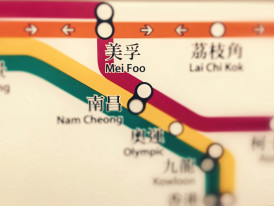
Subway map with highlighted route through major stops Photo by Thomas Kinto on Unsplash
Transportation Logic for One Day Success
Getting around Osaka efficiently requires understanding the subway system’s basic structure. The Midosuji Line forms the city’s spine, connecting all major districts you’ll visit. A day pass costs ¥ 800 and pays for itself after four rides.
JR trains connect to other cities and airports, but for within-city movement, the subway works better. The JR Osaka Loop Line is a convenient option for reaching major attractions like Osaka Castle and Tenjinbashisuji Shopping Street, and is easily accessible from JR Osaka Station. This makes it especially useful for a day Osaka itinerary, as you can quickly move between key sights using the JR rail network. If you have a Japan Rail Pass, tickets on the JR Osaka Loop Line are covered.
Walking between nearby attractions saves time and money while providing street-level cultural immersion. The distances between Kuromon Market and Namba, or between Namba and Tsutenkaku, are easily walkable and reveal neighborhood character that subway riding misses.
Peak hours (7-9 AM and 5-7 PM) bring serious crowds. Plan major movements outside these windows when possible. The trains still run on time, but the sardine-can experience might overwhelm first-time visitors.
Station bathroom stops, water bottle refills, and brief rest breaks become essential when covering this much ground. Japanese stations excel at providing these basic needs cleanly and efficiently.
Ready to plan your perfect day in Osaka?
Start your experience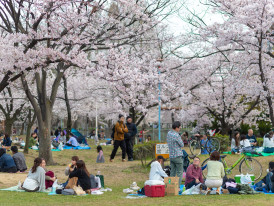
Cherry blossoms in Osaka Castle Park with visitors beneath
Weather and Seasonal Considerations
Osaka's weather dramatically affects the one-day experience. Summer heat and humidity make outdoor exploration challenging, plan more indoor stops and air-conditioned breaks. Winter cold makes outdoor walking less pleasant but creates clearer views from observation decks.
Spring brings cherry blossoms to Osaka Castle Park, transforming the morning portion of your itinerary into something magical but crowded. Plan for extended time here if you're visiting during peak bloom.
Rainy weather requires itinerary flexibility. The covered shopping arcades around Namba become more important, while castle park exploration becomes less appealing. Underground passages between stations keep you dry but limit street-level cultural observation.
Seasonal festivals occasionally disrupt normal transportation and attraction schedules. Check local event calendars before finalizing your route, especially during major holidays or summer festival season.
The city's rhythm changes with seasons too. Summer evenings extend later, winter afternoons feel shorter. Adjust your timing expectations accordingly.
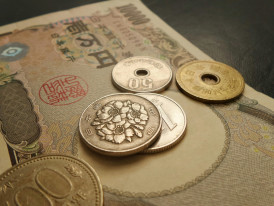
Japanese yen bills and coins on table with receipt Photo by Possessed Photography on Unsplash
Budget Breakdown and Money Matters
A realistic budget for one day in Osaka includes several unavoidable expenses. Transportation (subway day pass) costs ¥ 800. Major attractions range from ¥ 500-1,000 each, often with an entrance fee. Meals vary widely but budget ¥ 2,000-4,000 for decent food throughout the day. If you are planning your trip, consider searching for cheap flights to Osaka using popular flight search engines or by booking in advance to save on travel expenses.
Kuromon Market street food runs ¥ 300-800 per item. Umeda Sky Building observation deck costs ¥ 1,500. Spa World entry is ¥ 2,700 but includes multiple facilities and can occupy several hours.
Cash remains essential despite Japan’s increasing card acceptance. Many small vendors, especially in markets and local restaurants, operate cash-only. ATMs in convenience stores accept foreign cards reliably.
Souvenir shopping can quickly inflate budgets. Set spending limits beforehand if you’re tempted by Japanese design, electronics, or fashion. Quality is consistently high, but prices reflect that quality.
Restaurant tipping doesn’t exist in Japan - another budget advantage. The price on the menu is the price you pay, making expense tracking straightforward.
Is Osaka Worth Visiting in One Day?
After years of watching visitors attempt this challenge, I’ve concluded that 1 day in Osaka works precisely because it forces focus over coverage. Visiting Osaka for a day can be a highlight of your trip, offering a concentrated experience of the city's unique character. You can’t see everything, so you’re compelled to see things properly, to pay attention, to engage rather than simply consume.
The city rewards this focused attention. Osaka reveals its character gradually but generously to visitors who approach it with genuine curiosity rather than checklist mentality.
A single day provides enough experience to understand why Osaka inspires fierce local loyalty. The food culture isn’t just about famous dishes but about the social context surrounding eating. The urban energy isn’t just about density but about the particular way people interact within that density.
Many people visit Osaka as part of a broader itinerary when visiting Japan, often combining it with other destinations in the Kansai region. Whether you’re visiting Japan for the first time or planning a return trip, including a day to visit Osaka allows you to experience its top attractions and vibrant atmosphere.
You’ll leave wanting to return, which might be the best outcome of any one-day city experience. Instead of feeling like you’ve “done” Osaka, you’ll feel like you’ve begun a relationship with it.
For travelers seeking deeper cultural immersion beyond the standard tourist path, consider exploring Osaka experiences that connect you with local perspectives and hidden aspects of the city.
The surprise of a well-planned day in Osaka isn’t how much you can see, but how much depth you can discover within focused exploration. The city’s layers reveal themselves to patient observers, even those working within tight time constraints.
Final Thoughts on Sustainable City Exploration
The best Osaka experiences create understanding rather than exhaustion. Osaka teaches this lesson particularly well, its culture rewards depth over breadth, quality over quantity, authentic engagement over superficial coverage.
Your feet will hurt by evening. Your camera will be full of images that capture only fragments of what you actually experienced. Your mind will be processing cultural observations that take days or weeks to fully understand.
But you'll have spent a day in genuine contact with a remarkable city, not just passing through its tourist infrastructure. You'll have tasted its food, walked its streets, observed its people, and participated in its daily rhythm.
That participation, however brief, transforms you from visitor to temporary resident. For one day, you belonged to Osaka as much as you visited it.
The city will continue its life after you leave, but you'll carry something of its energy with you. That exchange - giving attention and receiving experience - justifies any amount of travel effort.
What if your day in Osaka was planned by someone who knows it — and you?
City Unscripted matches you with a local host who creates a private experience based on your interests, not a set route.
Want to experience the real Osaka with someone who lives there?
A fully private experience, planned and led by a local host who tailors the day to you
